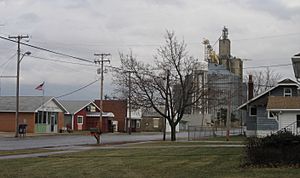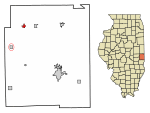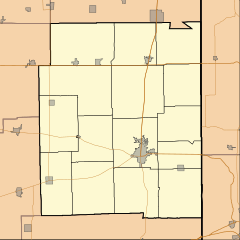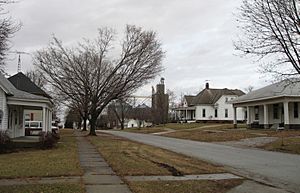Hume, Illinois facts for kids
Quick facts for kids
Hume
|
|
|---|---|
|
Village
|
|

Front Street of Hume, 2008
|
|

Location of Hume in Edgar County, Illinois.
|
|
| Country | |
| State | |
| County | Edgar |
| Township | Shiloh, Young America |
| Incorporated | 1873 |
| Area | |
| • Total | 0.57 sq mi (1.47 km2) |
| • Land | 0.57 sq mi (1.47 km2) |
| • Water | 0.00 sq mi (0.00 km2) |
| Elevation | 653 ft (199 m) |
| Population
(2020)
|
|
| • Total | 325 |
| • Density | 574.20/sq mi (221.81/km2) |
| ZIP code |
61932
|
| Area code(s) | 217 |
| FIPS code | 17–36568 |
| GNIS feature ID | 2398560 |
Hume is a small village located in Edgar County, Illinois, in the United States. It is part of both Shiloh and Young America townships. In 2020, about 325 people lived in Hume.
Contents
History of Hume
Early Times and Settlers
Long ago, the area where Hume is now was likely home to the Illinois Confederation of Native American tribes. Later, in the 1800s, white settlers came to the region. They often met and interacted with the Kickapoo tribe.
In the early 1800s, much of Illinois, including the Hume area, was covered in prairie grasslands. People thought this land wasn't good for farming. However, some people bought land, hoping it would become useful for growing crops later. Large groups of cattle often grazed freely on these open lands.
Railroads Arrive
A big change came in 1857 when plans were made for the Indiana and Illinois Airline railroad. Even though the tracks weren't laid until 15 years later, this railroad was very important.
In 1865, a man named Elzephan W. S. Hume moved to Illinois from Kentucky. He bought about 300 acres (1.2 km2) of land right along the planned railroad line. By November, he had started a farm and began growing crops.
The railroad was finally finished through Edgar County in the spring of 1873. Over time, this railroad grew and changed names many times. It eventually became part of the Baltimore and Ohio Railroad.
Founding the Village
In 1873, E. W. S. Hume decided to create a town on his land. At that time, there were no buildings there yet. He made a deal with the railroad company: if they built a train station in his new town, he would give them some land.
The village of Hume was officially planned in November 1873. The main people involved in setting up the town were Elzephan W. S. Hume, Henry C. Moore, Thomas H. McCoughty, and H. B. Hammond.
First Businesses and Growth
The very first house and store in Hume were built by O. H. Rogers. E. W. S. Hume became the village's first leader and also its first Postmaster.
Many other people started businesses and built homes in Hume during the 1870s. These included a blacksmith, a doctor, a veterinary doctor, and a hotel owner.
- Eben Hathaway, blacksmith
- O. H. Rogers, first house and store
- Dr. S. H. Bradley, physician
- Dr. Port Skeen, veterinary doctor
- Simeon Stark, store
- O. H. Linnabary, hotel
By 1879, Hume had 270 residents. The improved drainage of the prairie land made it easier to farm, which helped Hume grow in the late 1800s. By 1890, the village even had its own newspaper called The Weekly Record.
Another railroad, the Danville, Olney and Ohio River Railroad, came through Hume in 1881. This line ran north and south. In 1896, the Young America Cemetery was started.
Hume Manufacturing Company
In 1913, the Hume Manufacturing Company was created in Hume. This company made tractors with a new design. They built a factory across the railroad tracks from Front Street. Between 1913 and 1917, the company made 35 tractors. Later, another company bought Hume Manufacturing.
Geography
Hume covers a total area of about 0.57 square miles (1.47 square kilometers). All of this area is land.
Most of the village is located in Young America Township. However, a small southern part of Hume is in Shiloh Township.
Demographics
| Historical population | |||
|---|---|---|---|
| Census | Pop. | %± | |
| 1880 | 179 | — | |
| 1890 | 433 | 141.9% | |
| 1900 | 598 | 38.1% | |
| 1910 | 572 | −4.3% | |
| 1920 | 609 | 6.5% | |
| 1930 | 585 | −3.9% | |
| 1940 | 489 | −16.4% | |
| 1950 | 448 | −8.4% | |
| 1960 | 449 | 0.2% | |
| 1970 | 496 | 10.5% | |
| 1980 | 483 | −2.6% | |
| 1990 | 406 | −15.9% | |
| 2000 | 382 | −5.9% | |
| 2010 | 380 | −0.5% | |
| 2020 | 325 | −14.5% | |
| U.S. Decennial Census | |||
As of the 2020 census, 325 people lived in Hume. There were 202 households and 139 families in the village. The population density was about 574 people per square mile (222 people per square kilometer).
Most of the people living in Hume (96%) were White. A small percentage were from other racial backgrounds or from two or more races. About 1.23% of the population was Hispanic or Latino.
About a quarter of the households (24.8%) had children under 18 living with them. More than half (53.47%) were married couples. About 23.27% of all households were made up of people living alone.
The average age of people in Hume was 39.3 years. About 25.9% of the population was under 18 years old, and 17.0% were 65 years or older.
The average income for a household in Hume was about $56,964 per year. For families, the average income was around $65,208. About 15.8% of the total population lived below the poverty line.
Education
Early Schools
In 1870, E. W. S. Hume gave land for a one-room schoolhouse. This school was built by Peter Cockrell at the corner of East Street and First Street in the village. The first teacher there was Anna Grimes. In 1878, a second room was added to the school.
High school classes started after 1880. Because the school needed more space, classes were held in different places around Hume. The first brick school building was built in 1884. The bricks for this school were made in a local kiln. This school was located where the city park is now, at Center Street and Fourth Street.
New School Buildings
A cornerstone for another new school was placed on July 4, 1900. This school was built across Center Street from the old brick schoolhouse. A school gym was added in 1927.
In 1913, a special vote created a township high school district (District 148). This district covered a large area of about 20,160 acres (81.6 km2) in Edgar County.
Consolidated Schools
In 1947, several smaller schools from the Hume area joined together to form the consolidated school of Hume. These included schools like Baum, Dodd, and Maple Grove. On July 1, 1947, voters decided to create a Community Unit District that included Hume, Metcalf, and Brocton.
Finally, in 1967, voters agreed to build one central school for all grades, from kindergarten through 12th grade. This new school, called Shiloh School, opened in August 1968.
Religion
Before 1875, Christians in Hume had to travel to Chrisman, Illinois to attend church services. The Christian Church in Hume was officially started in 1875 by Christopher C. Boyer. J. W. Perkins was the first minister.
In 1880, the church members built a church building at the corner of East and Second Streets. Sadly, in 1916, the church was struck by lightning and burned down. The cornerstone for the current church building was laid on August 4, 1917, at the corner of Center Street and First Street.
A group of Methodists also formed a society in Hume in 1877. They held their meetings in a schoolhouse. Hume also has a Catholic Church named St. Michael's.
Notable Person
- Edward Adelbert Doisy, a famous biochemist, was born in Hume in 1893. He won the Nobel Prize in 1943 for his work.
Images for kids
See also
 In Spanish: Hume (Illinois) para niños
In Spanish: Hume (Illinois) para niños






